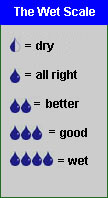
"[T]he animal shall not be
measured by man."
-Henry Beston
| 





LIVING COLOR
Coloring books are the medium most artists cut their teeth on. In the past, the whimsy of coloring has been limited to rudimentary drawings, with broad lines for ease of staying within them. Today's coloring books are a whole new breed. Even though the broad, easy-to-color formats still exist, publishing houses have added coloring books aimed at an adult audience, with intricate designs and details the books of our childhoods lacked. Coloring, it would seem, is no longer child's play.

Country Scenes: Coloring Book
by Dot Barlowe
Dover Publications, 2005
ISBN: 978-0-486-49455-5
$5.99, 31 pp
With thirty-one pages to color, Country Scenes offers hours of coloring activity. Drawn in the tradition of Currier & Ives, the scenes are highly detailed and challenging. The inside covers offer samples of finished works that will either inspire, or deflate, the artist in you. Each page is conveniently perforated for easy removal for framing. For best results (easy, nuanced shading for depth) try colored pencils, dry or wet.

Animal Designs for Coloring 12: Owls
by Ruth Heller
Grosset & Dunlap, 1979
ISBN: 0-448-14878-1
$2.50, 48 pp
Animal Designs for Coloring 12: Owls, offers 48 illustrations of - wait for it - owls. While not as detailed as Country Scenes: Coloring Book, Ruth Heller's drawings of these feathered predators allow their personalities to shine through. Included are single owls, pairs of owls, owls on roosts, horned owls, groups of owls, owls in flight, nesting owls, owls among reeds and flowers, and regal owls hanging out in the forest canopy. While Heller's interpretations are, for the most part, straight-forward, she does occasionally veer off into highly stylized territory. The result are owls that look more like Russian nesting dolls than the real thing, but beautiful all the same. If you like owls, you'll love this coloring book.

Pencil Drawing Techniques
edited by David Lewis
Random House, 1984
ISBN: 0-8230-3991-9
$16.95, 144 pp
   
Anyone who has read a book on art instruction knows how frustrating they can be. They're usually either too vague in their instruction, or so explicit as to over-complicate the thing they're teaching. Every once in a while, though, one comes along that achieves the correct balance between overly vague and too instructive, and hits the sweet spot, or as Goldilocks would call it, Just right. Pencil Drawing Techniques, edited by David Lewis, is one such book.
Seven in One
More than just an instruction manual, Pencil Drawing is the product of seven highly respected artist/authors on the subject, all published by Watson-Guptill, an imprint of Ten Speed Press (Random House). Ferdinand Petrie (Drawing Landscapes in Pencil, $21.95) lends his expertise on sketching landscapes. The late Rudy De Reyna (How to Draw What You See, $16.95) offers tips on realism, while excerpts from Douglas Graves' book Drawing Portraits ($16.95), provide tips on the tricky art of portraiture. For drawing animals, Lewis taps the expertise of Norman Adams (Drawing Animals, $21.99). In a section focused on watercolor, the thoughts of John Blockley (Country Landscapes in Watercolor) and Richard Bolton (Painting Weathered Textures in Watercolor) are shared. A section I was surprised - but thrilled - to see on the use of colored pencils is constructed around excerpts
from The Colored Pencil ($29.95), by Bet Borgeson, with over 65 full-color illustrations to aid the reader.

"Putting excitement and vigor in your watercolor paintings depends on your ability to capture in pencil the very essence of a subject . . ."
Beginning with basic fundamentals, Pencil Drawing leads the reader by the hand. While ideal for the novice, the basics provided by Lewis et al are beneficial to intermediate artists too. It never hurts to brush up on a topic you already know. Besides serving as a refresher, the artist/authors featured in Pencil Drawing are inspiring in both words, and images. Fundamentals covered include handling a pencil - yes, there is a wrong way to hold it - perspective, and shading. Artist Ferdinand Petrie offers tips and exercises, and instruction on creating a values chart of the different leads of your pencils. This proves particularly helpful in defining direction of light, and depth in your drawings.
When it comes to drawing for watercolor, the approach is slightly altered. Rather than striving for a complete drawing, the goal is representation of your subject's essence:
Putting excitement and vigor in your watercolor paintings depends on your ability to capture in pencil the very essence of a subject, so that you have a clear idea of exactly what you want to paint and can work out a plan for rendering the key textures before you begin to paint.
While the landscape, portraiture and animal sections of Pencil Drawing provide inspiring samples of work, reaching the level of the artists featured may take some time. These are professionals, and although they make it look easy, unless you're a prodigy, it's not. Still, the advice offered on getting there is invaluable; discouragement be damned.
Just Add Water
The section of this book that makes it a keeper for me, is on colored pencils. It's such a lowly tool, the colored pencil, too often relegated in art circles to the back of the classroom, next to the crayon. Neither strictly for drawing, nor painting, the colored pencil is a hybrid of the artist tool chest. Versatile, colored pencils can be used for line drawings, coloring, shading - everything a graphite pencil can - and more. Add a little water or solvent, and they lend a painterly "liquified" effect to a piece. The colors can be overlaid on each other to create infinite shades, or burnished for lightening and blending. The possiblities are endless.
Pencil Drawing doesn't promise to be painless. It doesn't provide a secret elixir to overcome frustration. But it does lay a solid foundation for anyone wanting to pursue the craft of drawing, be it figures, still-lifes, landscapes, portraits or animals. With tips that can easily be applied to other mediums, Pencil Drawing is a book you'll want for your shelves. And one you'll eagerly revisit time and time again. As a source of inspiration, balanced against instruction, Pencil Drawing is just right.
posted 03/16/22

TOP

| | |
|







